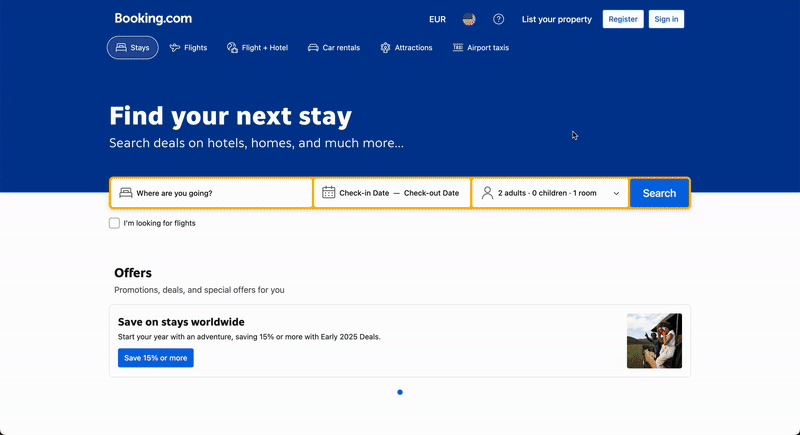¿Qué son las entidades de marcado de datos estructurados de Auditoría del sitio?
Para comprender mejor el significado de los elementos de datos estructurados, empecemos por definir algunos términos básicos.
¿Qué son los datos estructurados?
Los datos estructurados se refieren a un código creado utilizando el vocabulario schema.org y sirven para que las páginas de tu sitio aparezcan de una forma específica y mucho más llamativa (resultados enriquecidos o funcionalidades SERP) en los resultados de búsqueda.
Cuando utilizas datos estructurados, proporcionas a Google información detallada sobre el contenido de tu página, lo cual hace que tu sitio web aparezca en resultados de búsqueda especiales, llamados "funcionalidades SERP". (Más información en este artículo: ¿Qué funcionalidades SERP puede rastrear Semrush?)
Por ejemplo, una página de recetas con datos estructurados válidos puede aparecer en un resultado de búsqueda como imagen. Los usuarios pueden ver la foto de la receta, los ingredientes, el número de calorías y el tiempo de cocción sin visitar ninguna web. Si un sitio web aparece con una vista previa instantánea, es más probable que los usuarios hagan clic.
.png)
Para aparecer en los resultados enriquecidos, haz lo siguiente:
- Añade un fragmento de código de schema.org a la página. Schema.org es una gran colección de ejemplos de código. Google utiliza algunos de ellos para extraer los datos relevantes de tu sitio web y construir resultados enriquecidos (hay más de 30 elementos de datos estructurados que Google define). Por ejemplo, Negocio local (detalles del negocio, incluyendo horarios de apertura, valoraciones, direcciones) o Producto (información sobre un producto, incluyendo precio, disponibilidad y valoraciones de reseñas), etc.
- Utiliza uno de los tres formatos que admite Google, es decir, una de las tres formas de escribir un código: Microdatos, JSON-LD, RDFa. Estos formatos se utilizan para el marcado de datos estructurados.
- Proporciona las propiedades requeridas para un elemento de datos estructurados según las directrices de Google. Añadir más propiedades recomendadas puede aumentar la probabilidad de que tu información aparezca en los resultados enriquecidos.
Funcionalidad de marcado en Auditoría del sitio
Encontrar entidades de datos estructurados
La herramienta Auditoría del sitio puede explorar las entidades de datos estructurados de cada URL e identificar qué páginas pueden aparecer en los resultados enriquecidos.
Supongamos que te has dado cuenta de que tu competidor te está superando en una funcionalidad SERP y que quieres comprobar si el marcado está implementado en tu página.
En los filtros avanzados, selecciona "Elementos de datos estructurados" y elige los elementos que quieras comprobar.

En los resultados filtrados, navega hasta la columna Datos estructurados (si está oculta, añádela seleccionando esa columna en el menú Gestionar columnas) y comprueba si los elementos implementados en la página son válidos.
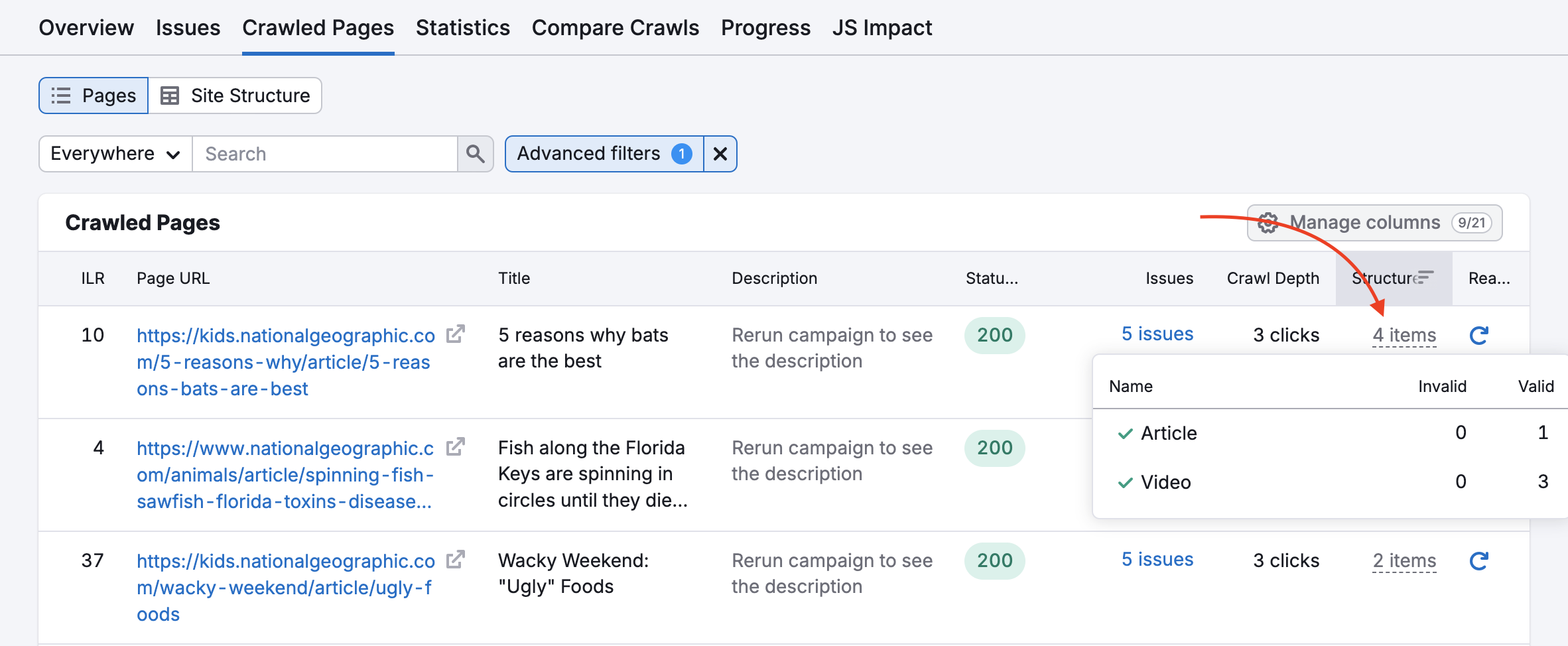
Semrush reconoce entidades de datos estructurados en los formatos Microdatos y JSON-LD. Las entidades de Schema.org en formato RDFa se utilizan mucho menos y actualmente no las admitimos. Para validar entidades en formato RDFa, recomendamos utilizar la herramienta Prueba de resultados enriquecidos.
La Auditoría del Sitio identifica la mayoría de los principales elementos de datos estructurados definidos por Google, excluyendo los que están en fase beta o con acceso limitado.
Importante: Nuestra herramienta no reconoce las propiedades definidas mediante el atributo itemref. El robot de Google es capaz de identificar estas propiedades; no olvides verificarlas con ayuda de la herramienta Prueba de resultados enriquecidos.
Verificación de objetos de datos estructurados
Hay dos aspectos que se deben verificar:
- Que no haya campos no descritos en schema.org.
- Que estén presentes todas las propiedades requeridas según la documentación de Google.
Informe temático
El informe temático es un buen punto de partida para analizar lo que hay y lo que falta en el sitio web:
- Busca las funcionalidades SERP para las que el sitio web no se posiciona (puedes hacerlo en Rastreo de Posición o en Investigación Orgánica).
- Utiliza Auditoría del sitio para comprobar si se ha añadido el marcado necesario y si es correcto.
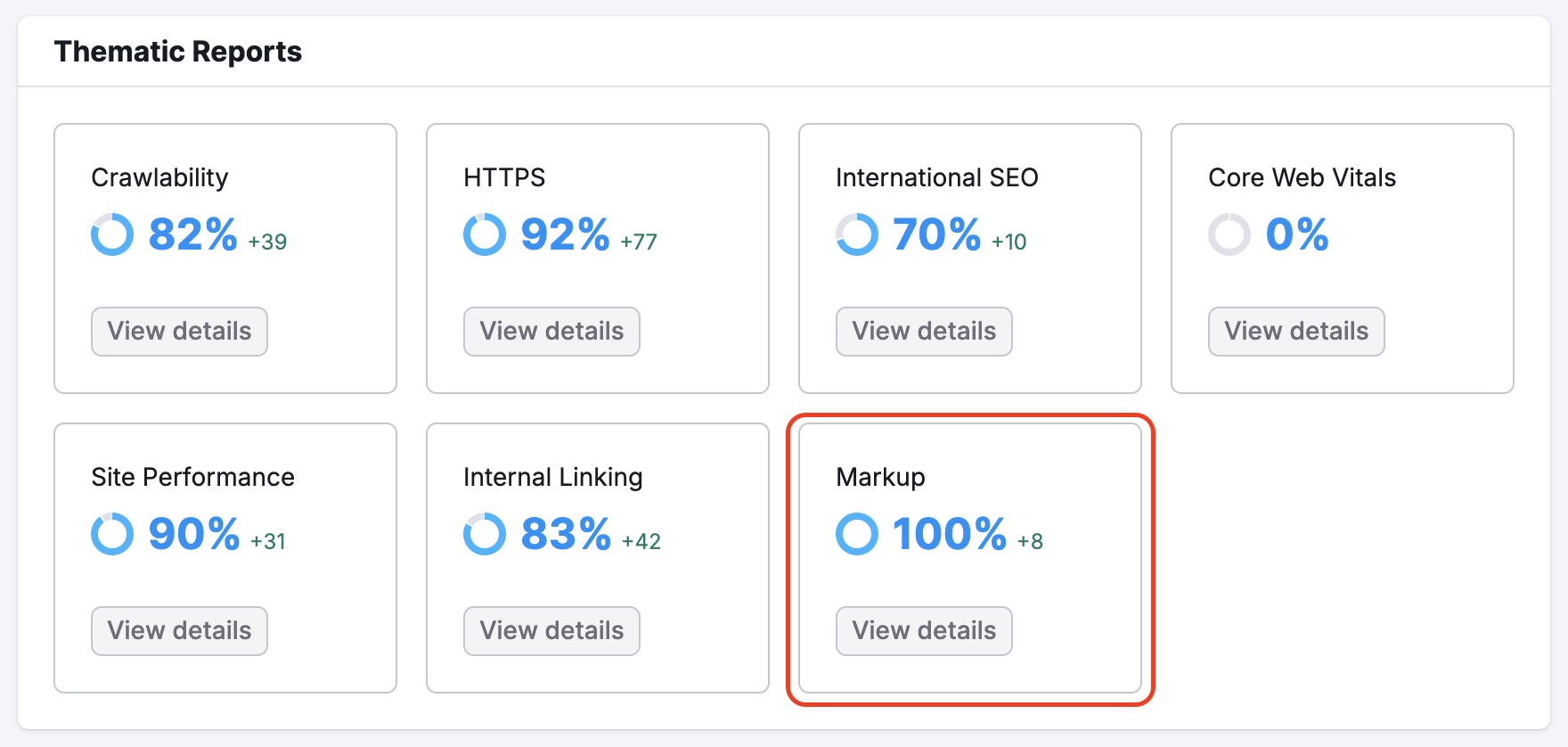
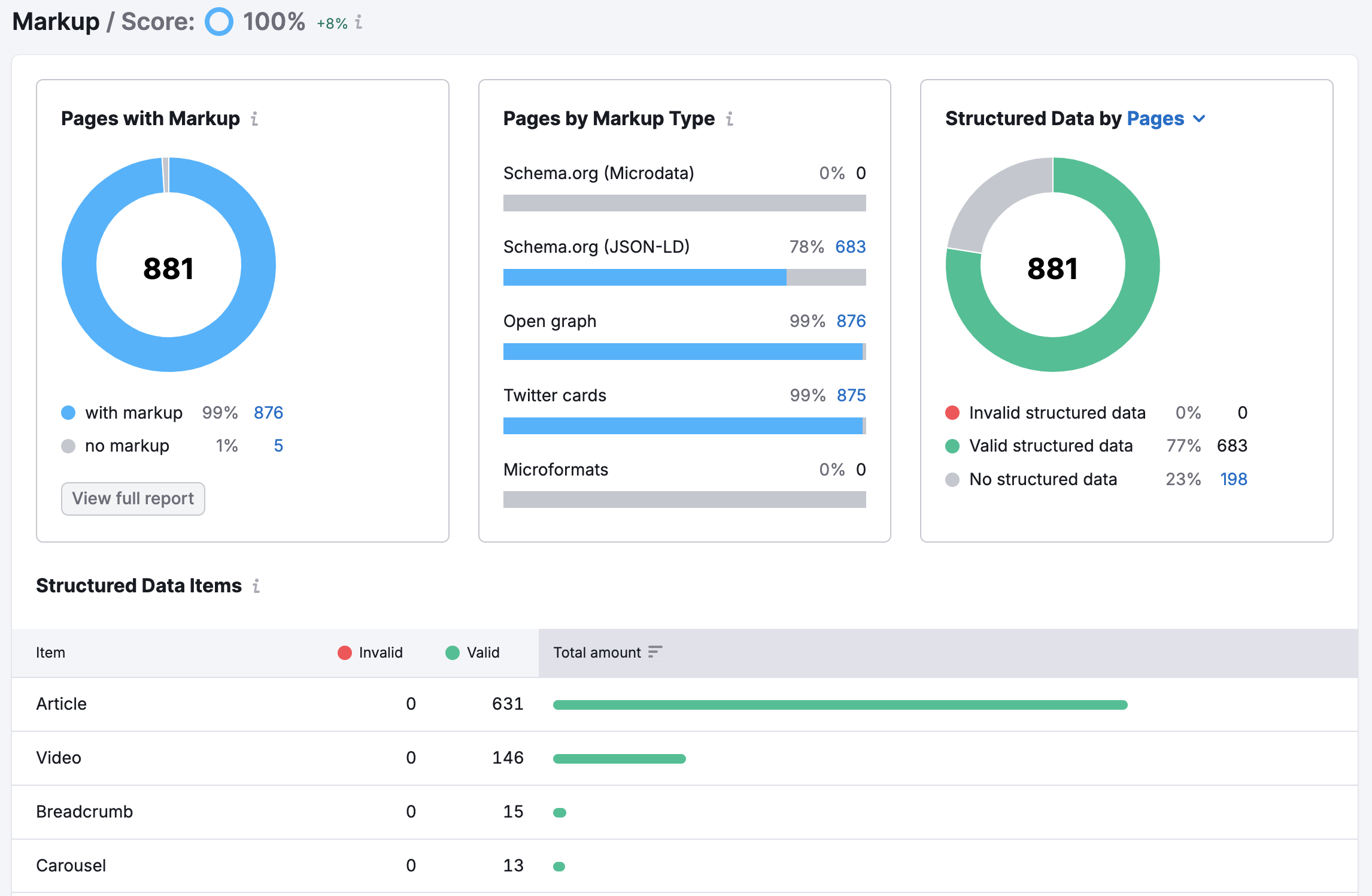
¿Qué entidades de datos estructurados reconoce Auditoría del sitio?
Aviso: Utilizamos el mismo vocabulario que Google, pero puede diferir del vocabulario de schema.org. Aquí tienes una lista de todas las entidades de datos estructurados que se admiten actualmente en Auditoría del sitio y cómo se indican en schema.org:
| Entidad de datos | @type en Schema.org |
|---|---|
| Artículo | NewsArticle o BlogPosting o Article |
| Libro | Book |
| Ruta de navegación | BreadcrumbList |
| Carrusel | ItemList |
| Curso | Course |
| Anuncios sobre el COVID-19 | SpecialAnnouncement |
| Conjunto de datos | Dataset |
| Calificación agregada del empleador | EmployerAggregateRating |
| Salario estimado | MonetaryAmountDistribution |
| Evento | Event |
| Verificación de datos | ClaimReview Claim (próximamente) Rating (próximamente) |
| Preguntas frecuentes | FAQPage |
| Instrucciones | HowTo |
| Anuncio de empleo | JobPosting |
| Empresa local | LocalBusiness, a elegir entre 148 tipos |
| Logotipo | @type: "Organización" y el campo "logo" |
|
Película |
Movie |
| Listados de comerciantes | Product |
| Organización | Organización |
| Producto | Product |
| Grupo de productos | ProductGroup |
| Fragmento de producto | Producto |
| Preguntas y respuestas | QAPage |
| Receta guiada | Recipe |
| Receta en la búsqueda de Google | Recipe |
| Fragmento de reseña | Review AggregateRating |
| Cuadro de búsqueda de enlaces de sitio | Sitio web con potentialAction: [{ @type: "SearchAction" |
| Nombres de sitio | WebSite |
| Aplicación de software | SoftwareApplication |
| Ficha de vehículo | Vehículo |
| Vídeo | VideoObject |
Nota: Las entidades de datos estructurados que aparecen tras renderizar el código JavaScript (como el que se proporciona con Google Tag Manager) solo se reconocerán si está habilitada la renderización JS.
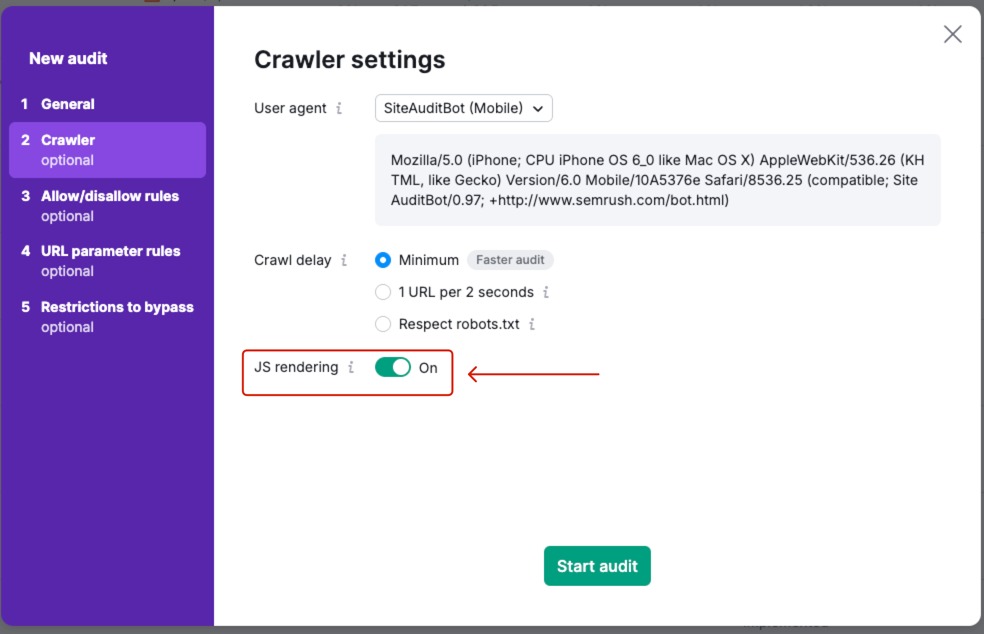
Ten en cuenta que esta función sólo está disponible con los planes Guru y Business del kit de herramientas SEO.
Para validarlas, abre la página en un navegador -> haz clic en "Ver fuente de la página" -> copia el código de la página -> pega el código en la herramienta Prueba de resultados enriquecidos.
